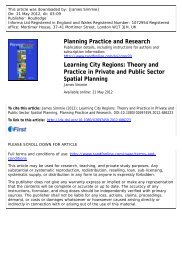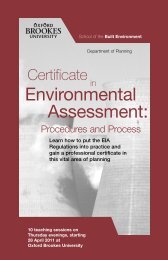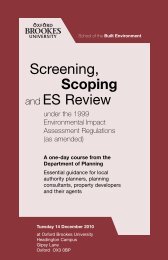History Matters: Path dependence and innovation in British city ...
History Matters: Path dependence and innovation in British city ...
History Matters: Path dependence and innovation in British city ...
Create successful ePaper yourself
Turn your PDF publications into a flip-book with our unique Google optimized e-Paper software.
Indicators of path dependent development<br />
Table 5: Location quotients – 2-Digit (1992 SIC)<br />
Indicator<br />
Time series<br />
Data source<br />
Geographic basis<br />
Def<strong>in</strong>itions<br />
Comments<br />
Location quotients for 2-digit sectors (1992 SIC).<br />
1981, 1991, 2005 (economic trough years).<br />
ONS: 1981 Census of Employment; 1991 Annual Employment Survey; 2005 Annual Bus<strong>in</strong>ess<br />
Inquiry.<br />
Data for local authority districts is best fit to 1998 TTWA boundaries (pre-1996 districts are<br />
used for 1981 data).<br />
Location quotient is the sector’s share of <strong>city</strong>-region employment, expressed as a ratio of the<br />
sector’s share of national (Great Brita<strong>in</strong>) employment. A location quotient above 1.0 <strong>in</strong>dicates<br />
a sector specialisation <strong>in</strong> the <strong>city</strong>-region, relative to the national average.<br />
None.<br />
Table 6: Location quotients – 3-Digit (1992 SIC)<br />
Indicator<br />
Time series<br />
Data source<br />
Geographic basis<br />
Def<strong>in</strong>itions<br />
Comments<br />
Location quotients for 3-digit sectors (1992 SIC).<br />
1981, 1991, 2005 (economic trough years).<br />
ONS: 1981 Census of Employment; 1991 Annual Employment Survey; 2005 Annual Bus<strong>in</strong>ess<br />
Inquiry.<br />
Data for local authority districts is best fit to 1998 TTWA boundaries (pre-1996 districts are<br />
used for 1981 data).<br />
See def<strong>in</strong>ition above for 2-digit sectors.<br />
Location quotients for 1981 are miss<strong>in</strong>g for some 3-digit sectors; this is because it is not<br />
possible to obta<strong>in</strong> an exact match between the sectors used <strong>in</strong> the 1980 SIC <strong>and</strong> 1992 SIC.<br />
Table 7: Sectoral employment change<br />
Indicator<br />
Time series<br />
Data source<br />
Geographic basis<br />
Def<strong>in</strong>itions<br />
Comments<br />
Employment change <strong>in</strong> 2-digit <strong>and</strong> 3-digit sectors (1992 SIC).<br />
1981, 1991, 2005 (economic trough years).<br />
ONS, 1981 Census of Employment; 1991 Annual Employment Survey; 2005 Annual Bus<strong>in</strong>ess<br />
Inquiry.<br />
Data for local authority districts is best fit to 1998 TTWA boundaries (pre-1996 districts are<br />
used for 1981 data).<br />
None.<br />
Data for 1981 is miss<strong>in</strong>g for some 3-digit sectors; this is because it is not possible to obta<strong>in</strong><br />
an exact match between the sectors used <strong>in</strong> the 1980 SIC <strong>and</strong> 1992 SIC.<br />
82













